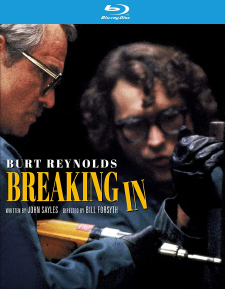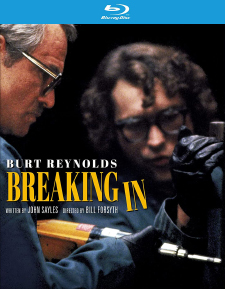Breaking In (Blu-ray Review)

Director
Bill ForsythRelease Date(s)
1989 (January 11, 2022)Studio(s)
The Samuel Goldwyn Company (Kino Lorber Studio Classics)- Film/Program Grade: B-
- Video Grade: B-
- Audio Grade: B
- Extras Grade: B-
Review
Breaking In is an amiable 1989 comedy pairing two unlikely suspects: Scottish director Bill Forsyth, and American screenwriter John Sayles. Both had long been stalwarts of the independent filmmaking scenes on their respective sides of the pond, but their sensibilities weren’t necessarily an obvious match. Yet the lighthearted screenplay that Sayles had written wasn’t material that he felt comfortable directing, so thanks to producer Harry Gittes, Sayles and Forsyth were brought together for the first and only time—in fact, Breaking In remains the only feature directed by Forsyth that he didn’t write.
The story is straightforward: Mike (Casey Siemaszko) is an unambitious mischief-maker who breaks into a house one night and encounters Ernie (Burt Reynolds), an older and perpetually cautious thief. Ernie has stayed out of trouble by keeping a low profile and distancing himself from those around him, but he takes a liking to Mike, so he decides to teach the tricks of the trade to the younger man. The trouble is, there’s more to being a successful thief than just knowing how to break into places, and some lessons are more difficult to impart than others.
The interesting thing is that Mike and Ernie are on opposite trajectories, so the intersection between them is just that: a period of time in which their two paths cross, destined to be a temporary one. In a strange way, they both learn from each other, though not always in the manner that either of them intends. Mike finally discovers a purpose in life, but it’s not necessarily the one that Ernie wanted for him. That’s driven home during the ending, where each of them walks away thinking that the other has made a mistake. They’re both wrong.
Reynolds wasn’t necessarily the first choice for the role of Ernie, but he’s great in the part, and Breaking In formed an important part of his transition from superstar leading actor into the elder statesman he would become. Siemaszko is fine as his opposite number, and Forsyth assembles a memorable supporting cast around them, including Lorraine Toussaint, Sheila Kelley, Albert Salmi, Harry Carey, Jr., Stephen Tobolowsky, and Maury Chaykin. (The film would be the final appearance for Salmi, who died the following year.)
Breaking In may have been written by Sayles, but it definitely feels like a Bill Forsyth film, so the quirky low-key humor may not be for all tastes. (The jokes did come from Sayles, but the slice-of-life rhythms came from Forsyth.) It’s the kind of comedy that elicits chuckles rather than belly laughs, but there’s nothing wrong with that. Despite all of the break-ins in Breaking In, it’s not really a heist picture, although one of the robberies is a classic in its own way. It starts out with an apparent nod to Rififi, but quickly takes a left turn thanks to an unusual canine encounter—even the dogs are quirky in this film. Ultimately, both the humor and the thievery are of secondary importance anyway, as Breaking In is primarily a character study of two people who briefly find common ground, and gain something unexpected in the process.
Cinematographer Michael Coulter shot Breaking In on 35 mm film using spherical lenses, framed at 1.85:1 for its theatrical release. Kino describes their Blu-ray as using a “brand new 2K master,” and while it does have its share of strengths, it also has some weaknesses. The biggest issue is a lack of consistency. The fine detail varies throughout, sometimes good, sometimes soft. The grain is subdued, perhaps a bit too much so, which means that DNR has been applied, but again, not in a consistent way. Damage is minimal. Contrast and black levels are solid, though there’s some crush in the night scenes. The color timing varies throughout, with the saturation levels changing, most obviously so with the flesh tones. They vacillate between looking natural in some shots, and too red in others. The changes in saturation are also visible in the surrounding greenery, which can look vivid in some shots, and more subdued in others. The differences aren’t dramatic, but they are noticeable, and they keep the transfer from looking as good as it could.
Audio is offered in English 2.0 DTS-HD Master Audio, with optional English subtitles. Breaking In was released theatrically in Dolby Stereo, so this is a four-channel matrixed mix. Since the film is a relatively modest character study, the mix is appropriately subdued, with some ambient effects in the surrounds, and occasional directional effects such as an airplane flying over the viewer, but the primary focus stays on the front channels. The dialogue and music drive most of the soundtrack, with the wry score from Michael Gibbs dominating the proceedings, but the dialogue always sounds smooth and clear.
- Audio Commentary by Bill Forsyth, John Sayles, and Daniel Kremer
- Trailer (SD – 2:04)
- Impasse Trailer (HD – 2:16)
- Fuzz Trailer (SD – 2:59)
- White Lightning Trailer (HD – 2:26)
- Gator Trailer (SD – 1:09)
- Semi-Tough Trailer (SD – 2:11)
- Malone Trailer (SD – 2:00)
- Stick Trailer (SD – 1:12)
Film Historian and filmmaker Daniel Kremer says that he feels starstruck participating in this commentary, and being placed in the middle between legends like Bill Forsyth and John Sayles, it’s not hard to see why. Forsyth admits to not having seen Breaking In since it was originally released, and Sayles acknowledges that he worked on so many scripts at the time that he can’t always remember what was in each one, so it’s nice to have Kremer acting as a moderator. He prompts them and asks questions when it’s necessary, but also gets out of the way when it’s not. Sayles has his own share of questions for Forsyth, like which elements that the director added to embellish the script. As a group, they talk about the history of the screenplay, how the production came together, the casting, stories from the set, and the film’s release. (Sayles explains that the idea for the umbrella during the robbery came from Evel Knievel, of all people, so any allusions to Rififi were entirely coincidental.) The track sometimes spins its wheels a bit as Forsyth and Sayles struggle to remember details, but Kremer does his best to keep it moving, and there’s plenty of good information to be had here. The rest of the extras consist of the film’s trailer and trailers for other Burt Reynolds films released on Blu-ray by Kino Lorber.
Despite the names above the title and the talents behind the camera, Breaking In never found an audience in 1989—though the lackluster promotion and release by The Samuel Goldwyn Company didn’t help. Forsyth only made two more features afterward before retiring from filmmaking completely. Yet his legacy is secure, and Breaking In is a neglected but worthy part of his filmography.
- Stephen Bjork
(You can follow Stephen on social media at these links: Twitter and Facebook.)

